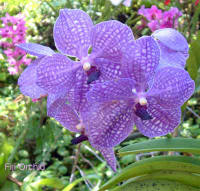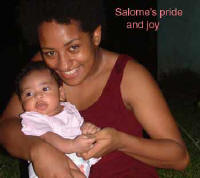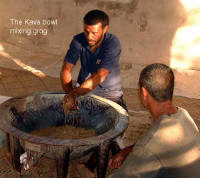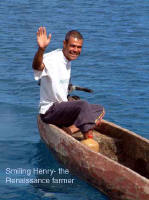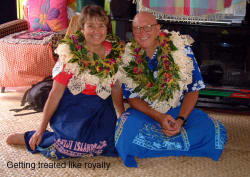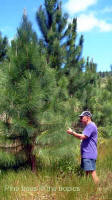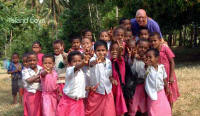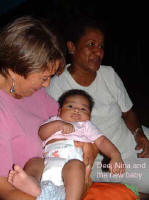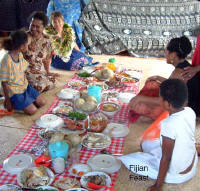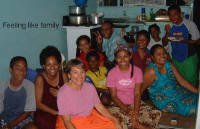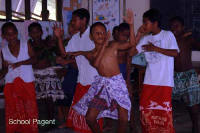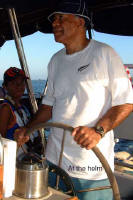American Samoa and Samoa
Cook Islands Fiji
Marquesas Moorea
New Caledonia
Pacific Crossing
Pacific Log Pacific Route
Pacific Passage Planning
Society Islands
Tahiti Tonga
Tuamotus Vanuatu

September - October 2003
Our 450 mile passage to Fiji was much like our other passages this year- light winds and large swells. If we tried to sail the big swells just rolled us side to side and with only a few knots of breeze there was not enough pressure in the sails to keep them filled so they slatted back and forth across the boat. After each roll they would refill with wind and the sound was like a bullwhip snapping. Too much of this breaks down the sailcloth material and causes the cars that hold the sail to the mast to break. After a few hours of uncomfortably rolling side to side in the swells we had traveled more distance sideways than we had forward, so we put on the engine. Our Pacific passages in 2002 were wonderful downwind sailing but this year we were feeling like a motor trawler. Other than 6 hours of a beautiful spinnaker run the entire 4 days was spent motoring.
But getting to Fiji was worth any effort as for us the country was to be a continuing series of very rewarding experiences. After our initial clearance into Savu Savu we sailed a few miles east to the Namale Resort owned by motivational speaker Tony Robbins. It was at one of Tony's "goal setting workshops" in 1991 that we had first written of our dream to retire early and go cruising so it was especially gratifying to sail in and drop our anchor at his resort. Tony is one of the most sought after speakers in the world today and he spends most of his time traveling and consulting with Heads of State and Fortune 500 companies,. In a stroke of good luck he happened to be at the resort that week, so we were able to see him. It was wonderful to tell him we had sailed 10,000 miles to thank him for giving us both the inspiration and success tools to make our cruising dreams come true. (www.tonyrobbins.com)
From here we took off to explore more of Fiji. Like most cruisers we usually follow the suggestions in the guidebooks and so end up at the same places as all the other boats. For a change of pace though we put the guidebook aside and just picked anchorages at random from our nautical chart. In a stroke of luck we happened to sail into a village where we were the first yacht ever to call there. This is absolutely amazing in a country that hosts millions of airplane tourists and at least 500-600 yachts each year. At the same time we were there a group of about 7 college age "missionaries in training" were in the village staying for a week. Clearly us and the missionaries were the first whites some of the children had ever seen. In honor of their visitors the kids put on skits at the school and then the entire village put on a feast for us.
A Fijian feast is an unbelievable experience. Mats were spread on the floor for the 100' length of the community building and heaping plates of prawns, fish, lobster, chicken, goat, taro, yams and more are spread down the length of the mats. All the food has been cooked in an underground oven called a lovo. Many of the dishes have been marinated in coconut milk and wrapped in banana leaves before being placed in the lovo so the food is tender and wonderfully flavored. Also traditional is a roast suckling pig cooked on a spit for several hours. While the women prepare the meal the men sit and drink many cups of ceremonial kava then when all is ready everyone sits on the floor and eats their fill.
After a few days enjoying the village we proceeded to Suva, Fiji's modern capital. A friend of ours in the US is lucky enough to have a Fijian woman, named Veronica, looking after her aging mother in San Francisco so we had an introduction to Veronica's sister and daughter living in Suva. When we called they invited us to get together the next evening saying they would come by for us in a taxi. We assumed we would go into town for a nice meal together and that would be it. Boy did we underestimate Fijian hospitality.
Nina, the sister, took us to the modest home of the daughter, Salome, where we were to eat. Upon arrival we were introduced to 15 family members who had come to meet us. The women had a lovo oven dug in the backyard and had prepared a Fijian feast for us. After a great many bowls of the traditional Kava drink the feast began. Dee and I were the guests of honor and so were brought heaping plates of food with at least 10 different dishes and bid to eat. They did not eat with us but rather just watched us eat and kept refilling our plates. Again we were seated on mats on the ground outside in their small backyard and under a special awning they had set up. When we were finished some of them ate. Later they sent us home with a "doggie bag" with about 10 lbs of food including a whole roast chicken and loads of vegetables. The only equivalent I can think of is organizing an entire Thanksgiving dinner including having 15 family members there and doing it on 24 hours notice.
The next day it was our turn to reciprocate and so we had the entire family out to Ventana and took them for a sail around the bay and outside the reef into the Pacific ocean. We all had a delightful time with everyone learning how to trim sails and taking a turn at the helm of Ventana. Our youngest crew member was 20 year old Salome's 6 week old baby. After arriving back in the anchorage to watch the sunset we provided fried chicken and cold beer which nice as it was paled by comparison to the meal the evening before.
While our new friends were sophisticated city people living in Suva and working on computers daily they are like all Fijians and consider their real home to be the village the family comes from originally. With this in mind they wanted us to visit their family village with them even though they had not been back in a year or two themselves. We agreed to accompany them on Saturday so a small van was arranged for that day to take us on a 2 hour drive to the village. Unbeknownst to us they also sent two family members ahead on Friday to alert the village and begin preparations for our arrival.
Upon arriving we presented an offering to the chief and were ceremonially welcomed into the village. Both Dee and Nina were allowed to sit at the back of the room while Rob joined the men in countless cups of Kava drink. After a few hours of this one of the village elders toured us around the village and explained its layout and all the traditions governing who lives where and where everyone can and cannot walk. He also showed us the modern land reclamation project they had planned with help from the Fijian government. After the tour and a few more cups of kava it was time for yet another feast.
This was similar to the first one in which long mats were placed on the floor and a number of us ate together. Unlike the other feasts though at this one we did not have any silverware but ate with our hands. Dee and I as the guests of honor had been presented with unbelievable leis that weighed about 3 pounds each. The village is the only one in all of Fiji that makes a certain style of woven fan. The leis had about half a dozen 6" fans woven into them along with flowers, greenery and other decorations. We were also presented with larger 8" diameter fans. During the feast a 13 year old girl sat between us to fan us and keep away the occasional fly that happened by. The feast included huge crabs, prawns, fish, chicken, etc, etc. After the feast we returned to the Kava room where the men were quietly getting "grogged." Before we left they presented each of us large 14" fans with our names woven into them.
The whole week with Veronica's family felt like one long outpouring of generosity and love. We were able to send photos of everyone back to Veronica in the US and give her glowing reports. The only cloud on the horizon was that her daughter, unmarried Salome, an extremely intelligent and personable 20 year old had quit her last year of college to have her new baby. Though she had some help from the baby's father she was now working to support herself and the infant.
Thinking of all the second chances we have had in our own lives convinced us we had to do something to help eager young Salome. After a few emails back and forth between us Salome, the college and Aunt Nina we were happy to tell Veronica that with some encouragement and assistance from us Salome will be able to finish her college degree.
One of our last stops in Fiji was the island of Kandavu. Again ignoring the guidebook we slowly picked our way into a likely looking anchorage in front of a pleasant looking village. As we had in all the other villages we went ashore carrying some dried kava root for a presentation of sevu sevu to the chief. The sevu sevu offering is a formal presentation of Kava which is the root of a pepper plant. The islanders grind the root up and make a semi narcotic drink out of it. You do not get drunk from it just sort of a slight numbness in the gums and vague sleepiness. Drinking Kava is done ceremonially in many of the Pacific islands and it is sort of like American Indians smoking a peace pipe.
This village was the most traditional we had so far visited. In other villages we had presented sevu sevu directly to the chief usually while sitting on the floor of his living room. Here Rob was not allowed to speak directly to the chief but had to present the sevu sevu offering through the Tauranga ni koro, who is the representative between the villagers and the chief. Before Rob could present it we had to go to the village communal building and then wait for about 6 village elders to gather. Each person had a special place to sit in the room including us. As before Rob made a short speech about why we were there and asked permission to visit the village. Next the chief made about a 5 minute speech welcoming us to his village. During this speech the others clapped and chanted several times in affirmation.
After the speech the kava was ground up and mixed with water in a carved wooden ceremonial bowl called a tanoa. The technique differed a bit from area to area but generally the kava was mixed with water, then strained out with a special type of tree bark leaving a sort of milky liquid. The kava is served in a bowl made of half a coconut shell and is given first to the chief then the visitors then each person in the room according to his rank. When the bowl heads your way you clap once say "bula," chug it down in one gulp then clap 3 more times. There are numerous rules about walking around in the room hunched over, touching the tanoa when leaving the room, etc. While the rules are sometimes complex and mystifying they are no more exotic than rituals surrounding a Catholic mass or Jewish Passover seder and we did our best not to offend our hosts.
In another odd coincidence of timing we had arrived at this village a day before they were to have a feast celebrating construction of a new village church. Again we were encouraged to join in and were made honored guests.
With time running short we had to prepare to leave Fiji and get on towards a safe haven for cyclone season so we proceeded up to Musket Cove. Now instead of having an anchorage to ourselves we were surrounded by other boats and in the midst of a 4 star resort that wonderfully opens all its facilities to the cruising yachts in the anchorage. We said hi to old and new cruising friends and joined in the nightly cocktail hours and BBQ's.
Not growing up in a sailing family or sailing community we have never been yacht club members. While we have enjoyed touring the model room and rarefied air of the New York Yacht Club, that had never been our style. Now however for the first time we became members of the exclusive yacht club fraternity- we joined the Musket Cove Yacht Club. The lifetime dues are $1 and the only other requirement is that you must have arrived via sailboat from a foreign port.
Next stop -- Mysterious Vanuatu
To read the next installment click here.
To enlarge any photo click on it then click on the back button to return here.















